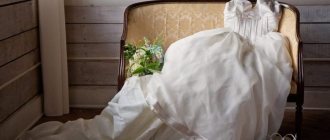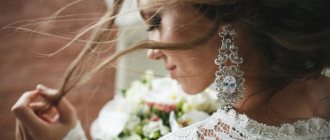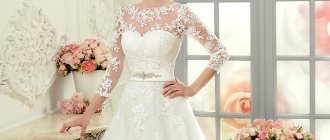Basic requirements for an outfit
The main requirement that is put forward when choosing a Muslim wedding dress is that the silhouette is hidden from prying eyes and discreet. The entire body (except for the face, hands and feet) must be carefully hidden. Openness of the shoulders, neck, and arms of a Muslim woman is unacceptable.
Floor-length, with a collar and long sleeves, traditional Muslim wedding dresses amaze with their exquisite detailing. Unusual decorative elements and intricate embroidery make wedding dresses for Muslim women a work of art. The outfit is made only from the best, high-quality, expensive fabrics (for example, silk or satin). The use of transparent materials is unacceptable.
A requirement that is unquestioningly fulfilled when choosing a wedding look for a Muslim bride is the presence of long sleeves (sometimes in combination with gloves) and a high collar.
The color of the bride's outfit is not tied to any canons. If desired, clothes can be either traditional white or other shades. The most relevant this season are: powdery, peach, golden, silver colors. For the young and stylish, a dress in rich colors is ideal. In Muslim countries, the image of a bride in red is welcomed. According to the strict rules of Sharia, the head must be covered. You can choose to complement the look with a veil or hijab.
The main differences between a traditional Islamic wedding dress are:
- regardless of the time of year and weather, the outfit must cover all open areas except the face, hands and feet;
- overly tight silhouettes are prohibited;
- rich decor;
- the infinity of colors of a Muslim wedding dress;
- It is mandatory to have a headdress that hides the bride's hair.
Muslim bride makeup
Since the bride’s image is characterized by a closed dress without a neckline and a Muslim wedding hijab, the girl’s face is the part of the body that will attract all the guests’ eyes. With the help of makeup, brides try to stand out and emphasize their individuality and natural beauty.
Naturalness, neatness and neatness prevail in the image of a Muslim bride. Natural makeup allows you to hide skin imperfections and correct your face shape, emphasizing your natural features. Basically, foundation is used to even out the tone, light blush to highlight the contour of the face, eye shadow, mascara and lipstick of any shade.
The use of bright lipstick and eye shadow is allowed. Sometimes they make a bright accent on the eyes, using shadows, eyeliner and even false eyelashes, which emphasize the girl’s bright look.
Varieties
The limits of what is permitted in choosing a Muslim dress for a wedding are determined by each nationality professing the religion of Islam. For some, deviations from strict requirements are possible, while in others a girl can only choose a closed white dress.
But, despite the restraint of the style of Muslim wedding attire, the bride’s dress is a work of art that is often passed down from generation to generation. The dress is embroidered with pearl beads and precious stones, and embroidered with silver or gold threads.
The silhouette is carefully selected. At the same time, the strict outfit subtly emphasizes the femininity of the Muslim bride.
A few secrets of choosing a Muslim wedding dress:
- slender girls will appreciate the “fish” silhouette that outlines the hips and narrow waist;
- Brides with curvy figures should choose dresses with full skirts.
Traditional
The classic dress of a Muslim bride combines a straight, slightly fitted silhouette, long sleeves, and a closed neckline. The not tight, but delicately elegant silhouette very carefully emphasizes the female figure. It is in this form that a girl can look both strict and femininely attractive. The dress is made from high-quality, expensive fabrics (satin, silk) with the addition of textured openwork fabrics (for example, guipure).
The traditional image of a Muslim bride is impossible without a skillfully embroidered silk scarf (hijab) that hides her hair and ears.
Lush multi-layered
Airy, amazingly beautiful dresses with a multi-layered chiffon-based skirt will help you create an attractive, stylish and very fashionable look. The skirt of the dress is made of chiffon, gathered in layers in the shape of a rosebud. In combination with embroidered pearls and beads on the bodice, you get a very stylish, amazingly beautiful outfit.
A-line
The fitted bodice and widened hem of the dress help to gracefully and very delicately outline the graceful figure of the bride. The skirt widens from the waist. A-line dresses are preferred by Muslim brides, noting the amazing combination of modesty and grace in such a dress. The outfit is decorated with gold or silver embroidery and complemented with a long train.
Fitted
A fitted lace dress amazingly emphasizes the youth and innocence of the bride. Covered shoulders and arms soften the eye-catching lines of the female figure, making the bride's image more elegant and sophisticated. It is worth noting that the fitted silhouette is extremely trendy this season. Precious stones and beadwork add luxury to the dress. Convex decor creates a unique three-dimensional effect on clothes. The fitted silhouette is often complemented with a fish skirt. This image looks very gentle, without violating the strict Muslim canons of women's clothing.
Wedding looks
In order to avoid the pain of choice and make preparations for the wedding even more pleasant and easy, we suggest that you familiarize yourself with ready-made images for brides. Here new ideas resonate with recognized classics:
- A dress with a straight cut and a fishtail cut will look great with a new trend in the world of wedding fashion - a cape instead of a veil. A lace cape adds mystery and lightness to the look without weighing it down, as can happen with a fur coat or cardigan. In addition, it is quite capable of replacing a tiara or hoop;
- Dress A silhouette can be decorated with a beautiful, large bow made of satin ribbon. For lovers of the classics - white, for bold experimenters - red, black, blue or coffee. If miniature, neat bows are present on the shoes, the image will be even more tender and sweeter;
- Bridal images not in classic pastel colors, but in bright, rich colors are gaining great popularity. The image for a bride in red, bold and bright, is suitable for young ladies who are confident in themselves and their sexuality. The blue color looks very noble, elegant, and emphasizes the status of the newlywed;
- For a bride whose wedding will take place in the summer, you can choose a dress of midi or mini length, made of light, flowing fabrics. A beautiful addition to the look will be everyone’s favorite ballet flats or pumps, pearl earrings, a wreath of snow-white flowers in your hair;
- For a winter bridal look, instead of the usual boleros or short fur coats, choose a warm shawl or cape-mantle. Then the image will sparkle with new colors.
Thanks to such simple tricks, choosing a straight-cut dress for the bride will become much easier, and preparing for this special day will turn into a wonderful prelude to a miracle.
Decor options
Muslim wedding dresses, the photos of which are striking in their beauty, are distinguished by their rich decor. Decoration with precious stones, beads, rhinestones and pearls, sewing with gold and silver threads create shimmering three-dimensional patterns throughout the dress. Guipure lace fabric embroidered with beads is especially popular among Muslim brides. The decor can be either one color or multi-colored. This helps create amazingly beautiful intricate patterns.
European trends in wedding fashion make small adjustments to the outfit of a Muslim bride. The outfit can be complemented with a neat stand-up collar (ideally emphasizing the beauty of the neck) or a light corset (emphasizing the bride’s thin waist). Muslim brides also liked asymmetrical sleeves. Elongated at the back and slightly shortened at the front, they allow you to delicately demonstrate a girl’s graceful hands without violating strict rules.
Jewelry and headdress
The main accessory that complements the image of a Muslim bride is the hijab headdress. According to strict canons, only the future spouse and immediate family are allowed to see the hairstyle of an Islamic bride. During the wedding celebration, the head must be covered with a hijab. This lightweight scarf is made from flowing silk fabric. The hijab is skillfully decorated with embroidery with gold threads, lace, and precious stones.
As an option, instead of a hijab, the bride’s head can be covered with a wide scarf or scarf, or a veil with a veil.
For a wedding, an Islamic bride can choose the following accessories:
- a small elegant bouquet of flowers;
- a miniature handbag, matching the dress in color and decor;
- jewelry: bracelets, rings, necklaces. Fine jewelry decorated with precious stones not only decorates the bride’s outfit, but also determines the status of the groom’s family. Earrings are included in the bride's outfit only if she wants to show them to her husband. To outsiders, the earrings are hidden under the fabric of the hijab.
There are no strict rules for choosing shoes for the wedding look of a Muslim bride. The main thing is that it is comfortable (the wedding ceremony is quite long) and closed (the shoes support the overall style of the Muslim wedding attire).
Classic and restrained does not mean boring and faceless. Despite existing restrictions and prohibitions, Muslim wedding fashion has many faces and gives every bride the opportunity to choose the perfect wedding dress.
Pre-wedding ritual among Muslims
Muslims are distinguished by the fact that they like to celebrate celebrations in a big way. They believe that if the wedding is successful, happiness and wealth will await the newly-made family.
Every Muslim adheres to certain traditions, thereby emphasizing the upbringing of the bride and groom. If a family does not follow traditions, it means that the likelihood of giving a daughter in marriage or marrying off a son decreases significantly.
Muslim wedding customs are divided into several stages:
- matchmaking process;
- the onset of henna night;
- undergoing the nikah ritual;
- festive banquet.
Not only newlyweds, but also their relatives go through them.
Matchmaking process
Regardless of nationality, before a wedding, every nation goes through a matchmaking process. Among Muslims, the future spouse of a son is chosen by the mother or the eldest of the sisters. But first, the groom needs to tell him what kind of chosen one he wants to see next to him.
The choice of the bride occurs according to several parameters in the form of:
- the desired height and weight of the girl;
- figure and appearance;
- education;
- housekeeping;
- family status in society;
- the girl's religiosity;
- tastes, preferences and interests.
Muslim men prefer to choose curvy women. This people even have one tradition - the future wife shows her ankle to the groom's relatives. If her leg turns out to be plump and decorated with bracelets, then her family has a high position in the public. A thin ankle with calluses and lack of jewelry indicates the girl’s poverty.
Meeting of young people
As soon as the mother or sister has found a bride for the guy, the dating process begins. Based on ancient traditions, young people meet in the girl’s house. The future spouse and family do not come empty-handed. They carry expensive gifts and jewelry with them. This is how they demonstrate their wealth.
During the first acquaintance, young people are allowed to exchange phrases. If the family strictly follows all the canons of religion, then the girl and the boy can evaluate each other visually.
After meeting, the girl has a week to think and make a decision. After 7 days, the woman and her family announce their choice. If a refusal occurs, the gifts and decorations are returned back.
Before the ceremony, a young couple can only meet in the presence of relatives. They have no right to touch each other. The girl dresses in a closed dress. The groom and his parents look only at the face and hands of the chosen one, which are used to assess the appearance and health of the future wife.
The arrival of the night of henna
Henna Night is considered a necessary part of a wedding celebration. The ceremony is performed immediately before marriage.
This process is usually understood as the application of mehendi. Various shapes are drawn on the hand of a girl and a guy using henna.
Drawing is considered an art. By tradition, only those women who live happily in marriage are allowed to paint. There is a meaning hidden in every curl, which is why Muslims take mehendi drawing seriously.
For girls, henna is applied to the palms and feet. For this purpose, very good and durable paint is selected. There is a custom: the longer the design is on the future bride’s hand, the longer she is not allowed to do household chores.
There is one more important point. Muslims hide the initials of the groom during a wedding. And only after the first wedding night will he be able to reveal them. This belief allows a young couple to get to know each other better.
The groom's palms are painted. He spends the last night before the wedding with friends. At the same time, it is not allowed to violate Muslim traditions.
Passing the Nikah ritual
A mandatory condition for an Islamic wedding is a wedding in a mosque. According to traditions, the marriage process is usually called Nikah. It does not matter in what part of the world the celebration will take place. The main thing is that everyone present strictly follows the laws of the Koran.
Wedding among Muslim people plays one of the important roles in creating a family. But it has no legal force. Because of this, after the completion of the ceremony, the young couple goes to the registry office.
Nikah is a kind of appeal to others. It says that the bride and groom have decided to unite their destinies. Thus, society learns about the creation of a new family.
To get married in a mosque, several conditions must be met.
- Before the marriage process, consent is taken from both the groom and the bride.
- The newlyweds are not close relatives.
- The groom is presented with a bride price for the bride. It is understood as monetary reward or jewelry. The husband also makes a promise to fulfill his wife’s wishes.
- There must be at least one man on the bride's side at the wedding.
- The young people must have witnesses. Often these are two close men. But according to the Koran, a woman is allowed to be present at the celebration. Only by law, instead of one man, there must be 2 women present.
The celebration in the mosque is carried out with the help of a mullah. For about an hour he reads suras from the Koran to the spouses. From them, newlyweds draw knowledge and instructions that will be needed for future family life. After this, the newlywed is given gifts. The list of offerings is written down in the marriage certificate.
There is another special wedding tradition: during the wedding, the future husband must voice the amount of the gift to the bride. Among the Muslim people this is called mahra. It consists of jewelry, monetary reward, etc. The husband must pay Mahru to his wife throughout his family life or in case of divorce. Thus, the man shows that he has serious intentions.
The completion of Nikah is accompanied by the exchange of rings. They are usually made of silver.
In addition to the traditional wedding, which takes place within the walls of the mosque, the newlyweds register their marriage in the registry office.











